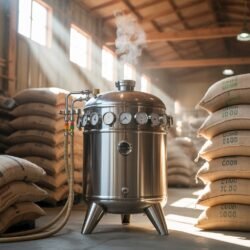Coffee is more than just a beverage—it’s a complex chemical symphony, with each processing method playing a unique role in shaping the final flavor in your cup. Among the most transformative techniques in specialty coffee is anaerobic fermentation, which uses controlled, oxygen-free environments to unlock new dimensions of taste and aroma. In this article, we’ll explore the chemistry behind coffee and how anaerobic fermentation specifically influences its flavor profile.
The Building Blocks of Coffee Flavor
At its core, coffee flavor is the result of a vast array of chemical compounds. These include acids, alcohols, esters, ketones, aldehydes, and more, each contributing to the aroma, sweetness, acidity, and body of the final brew. The raw coffee cherry contains sugars, proteins, and other compounds in its mucilage, and it’s during fermentation—whether aerobic or anaerobic—that these are transformed.
The Anaerobic Difference
Anaerobic fermentation stands apart from traditional processing by taking place in sealed, oxygen-deprived containers. This unique environment changes the microbial activity, favoring certain bacteria and yeasts that thrive without oxygen. The absence of oxygen slows down some reactions while accelerating others, leading to a distinct chemical signature in the final coffee.
Key Chemical Changes During Anaerobic Fermentation
Microbial Transformations
Inside the sealed fermentation vessel, naturally occurring yeasts and bacteria—such as Lactobacillus, Leuconostoc, and Saccharomyces—begin breaking down sugars in the coffee mucilage. These microorganisms produce enzymes that convert sugars into organic acids, alcohols, and other flavor-active compounds. The result is a cascade of chemical reactions that build complexity and depth.
Volatile Compound Formation
Studies have shown that anaerobic fermentation leads to the production of a remarkable variety of volatile compounds. In one analysis, 76 volatile compounds were identified, grouped into nine categories: alcohols, ketones, esters, free fatty acids, aldehydes, hydrocarbons, terpenes, acids, and others. Alcohols, in particular, are the dominant group, with ethanol and other higher alcohols contributing to fruity, floral, and sometimes boozy notes in the cup.
Esters are another crucial group, formed when acids and alcohols combine. These compounds are responsible for many of the fruity and floral aromas that characterize anaerobic coffees. Ketones and aldehydes add complexity, while terpenes like linalool contribute floral and citrus notes.
Acid Profiles
Anaerobic fermentation also influences the acidity of coffee. Lactic acid and acetic acid are produced in higher quantities, contributing to a wine-like acidity and bright, tangy flavors. The pH of the fermentation environment drops as acids accumulate, further shaping the final flavor profile.
How Fermentation Time and Temperature Shape Chemistry
The duration and temperature of anaerobic fermentation are critical variables. Longer fermentation times allow for greater accumulation of alcohols, esters, and other volatile compounds. For example, after 72 hours of fermentation, a much broader spectrum of alcohols and esters is present compared to shorter periods. Temperature also affects which microorganisms dominate: cooler conditions favor lactic acid bacteria, while warmer environments can encourage the growth of acetic acid bacteria and certain yeasts.
The Flavor Impact
The unique chemical environment created by anaerobic fermentation results in coffees with:
- Enhanced Fruitiness: Tropical fruit, berry, and citrus notes are common, thanks to the abundance of esters and alcohols.
- Wine-Like Complexity: The presence of lactic and acetic acids, along with ethanol and other alcohols, creates a winey, fermented character.
- Floral and Spicy Nuances: Terpenes and other aromatic compounds add layers of floral and sometimes spicy complexity.
- Sweetness and Body: The breakdown of sugars and the formation of certain acids and alcohols can enhance perceived sweetness and mouthfeel.
The Role of Bioactive Compounds
Anaerobic fermentation not only shapes flavor but also influences the bioactive compound content of coffee. Research indicates that this method maintains high levels of bioactive compounds, such as chlorogenic acids and trigonelline, which contribute to the antioxidant activity and health benefits of coffee. These compounds also play a role in the bitterness and overall sensory experience.
Conclusion
Anaerobic fermentation is a masterclass in coffee chemistry, leveraging controlled environments and microbial activity to unlock flavors that are impossible to achieve through traditional processing. By understanding the chemical transformations at work—from the production of esters and alcohols to the modulation of acidity and bioactive compounds—we gain a deeper appreciation for the artistry and science behind every cup. For coffee lovers, anaerobic fermentation offers a window into the extraordinary potential of coffee as a medium for flavor innovation.


